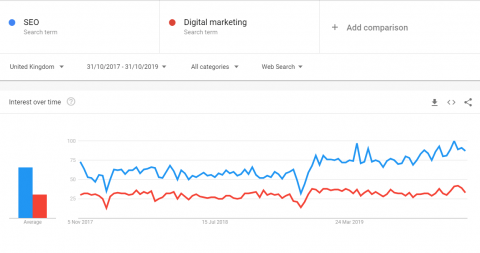There are a number of considerations that should be taken into account if effectively forecasting the return on investment (ROI) for any organic campaign. By applying a blend of different methods (and through a little support from some industry-leading tools) you’ll be in a position to benchmark organic performance and work towards strategic key performance indicators (KPIs).
What to do before forecasting
Before you can start forecasting, it’s worth making sure that some key areas have been addressed, as listed below:
- Complete keyword research: without this information you cannot accurately determine an uplift in traffic and plot forecasted rankings you want to achieve for your search terms.
- Action high priority technical recommendations: we advise carrying out a technical audit at the beginning of any organic strategy. This will highlight major red flags. Those bigger issues (e.g. multiple HTTP URLs over HTTPs in place, the majority of URLs returning 404 errors, etc.) should be fixed straight away as these will significantly skew your base level of monthly organic traffic.
- Ensure your site is effectively being tracked through your Analytics platform and Google Search Console: without understanding current performance it will be difficult to determine growth.
Once these key areas have been addressed you can begin utilising several data sources and tools to build a robust forecast. At this point we would recommend considering all factors below to identify an opportunity for growth:
- Apply ‘target ranking positions’ to your keyword research: Identify how keyword rankings will improve for each keyword after 12 months. Using the click-through rate of that position multiplied by its search volume, you can identify the potential impact on organic clicks over 12 months.This can be time-consuming, but it can be done at scale by easily identifying achievable positions for keywords that are deemed ‘low competition’. There are also industry tools such as SEO Monitor that can help with the automation of this process, effectively forecasting a target position based on keyword competitiveness.
- Look at historical performance within your Analytics software: determine if there is a trend in month-on-month (MoM) and year-on-year (YoY) growth that can be applied to your forecast. Are there any seasonal peaks or drops that should be applied to individual months?
- Look at Google Trends: whilst Analytics may tell you if your business is growing, what about the overall marketplace? Have the search terms for your products increased in demand every year? If so, this should be factored in as natural growth and applied to your forecast (prior to any additional uplift).

- Look at competitor visibility: How have your immediate competitors (that rank for a similar keyword set) grown their visibility? Have they also been delivering the core strategies outlined in your organic roadmap? If the answer is yes, then their uplift could be a reasonable target for your business. There are a number of organic tools such as SEMRush and Sistrix that allow you to measure organic visibility over time and support you with this analysis.
Once you have considered all these factors, you should balance your numbers to determine a clear percentage of growth for your organic forecast. This should be over a minimum period of 12 months and then monthly targets should be reverse engineered based on seasonality performance (obtained from one of the data sources listed above).
After this is done you can plug in your Analytics data to give you a clear indication of organic traffic. This can be clicks, impressions or sessions depending on your requirements.
What if my website has no legacy traffic?
If your website is in its infancy and no meaningful data can be obtained, we recommend identifying an uplift percentage based on the overall search volume that your keyword universe will grow by. By understanding how many more keywords your site will rank for as a result of your organic strategy, you can attribute the growth in potential organic clicks.
What about sales and conversions?
To forecast sales, apply the same level of growth to current sales/conversion numbers, however, if carrying out CRO/UX activities be mindful of improved MoM conversion rates and how this may improve over time.
Sales/conversions can be revenue, transactions, or goal completions. Essentially whatever conversion is being tracked that is most suitable to your business.
“What if you don’t have sales/conversion data?” I hear you ask. This is a very common issue for businesses that may not have e-commerce tracking enabled in their Analytics platform.
If this is the case, we would advise utilising key product information (e.g. typical conversion rate, average order values, etc.) and applying these to your organic traffic numbers to build out a complete view on organic ROI.
But don’t stop there – interrogate that first-party data!
Before finalising your forecast, check that your analytics data aligns with your business data. If your conversion value in Analytics does not match that of the business adjust the conversion value within your forecast accordingly to reflect a true picture of performance.
Once this has been obtained, we would advise applying this growth percentage to organic sessions for a more accurate reading of organic traffic.
Then that’s it! … Or is it?!
After applying these steps you should have a robust organic forecast. However, we recommend regularly re-forecasting the number once a true reflection of MoM and YoY performance has been obtained.
Unfortunately, all numbers are dependent on algorithmic changes in the industry and timely implementation of all recommendations outlined in your roadmap. So factor this in and reevaluate performance when comparing how your monthly performance stacks up to the forecast.
Forecasting organic ROI can be a tricky business, especially with several factors to consider, however, should you need any further support in this area, Koozai would be happy to help.







Leave a Reply